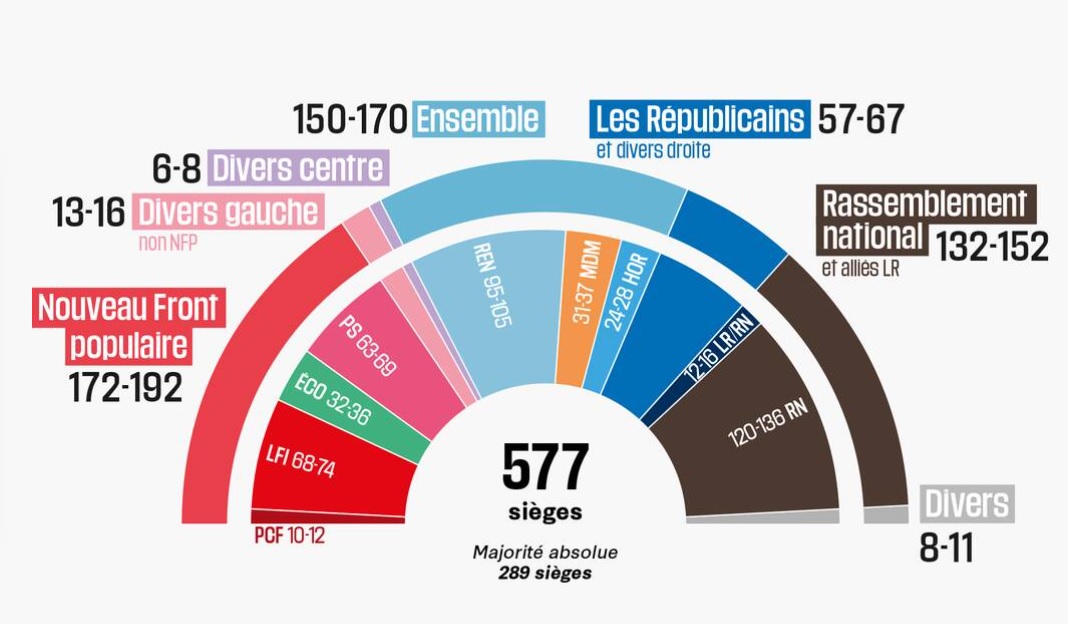
French pollsters and media began reporting preliminary results on Sunday from the second round of the National Assembly elections, showing a Major setback for the far right of the National Rally (RN, for its acronym in French) which in recent weeks was positioned as the undisputed winner.
According to the first preliminary data, the National Assembly would be divided into three thirds (and other minor forces) between the New Popular Front – NFP (Socialist Party, Communist Party, Greens and La France Insoumise of Jean Luc Mélenchon) obtaining first place, followed by Ensemble (Together)the coalition of President Emmanuel Macron, and only in third place National Grouping (RN) by Le Pen.
Considering that these are partial results, the second and third places in the National Assembly may change with the final results. In any case No party obtains an absolute majority of 289 seats so that the prime minister can impose himself without making agreements with any other force.

The results published by the IPSOS polling company show that NFP with between 172 and 192 seatsa Together with between 150 and 170 seats already RN with between 132 and 152 seats. Then comes the traditional right of Republicans who could have obtained between 57 and 67 seats.
The lesser evil: Republican blockade of the far right
He retreat of the extreme right of the National Group in this second round It is explained by the agreement called Republican Front or Republican Blockade by which the applicants of the New Popular Front, Macron’s Juntos and some of LR, lowered their candidacies to favor candidates from other parties so that they could beat those from the National Rally.
In the French electoral system, not only two candidates go to the second round, but all those who had obtained more than 12.5% of the votes in the first round, so in this case there were many cases in which the second round was contested between three or even four different candidates. It was in these cases that the NFP and Juntos withdrew their candidates who had come in third or fourth place to prevent the RN from winning. Most of the candidates who dropped out were from the NFPWhich explains also the rise of Juntos, of Macron, in this second round.
That is to say the Lesser evil policy to block Le Pen’s partywhich included that the New Popular Front candidates bow down to totally unpopular figures in Macron’s government such as his former prime minister, Elisabeth Borne, or Macron’s interior minister, Gérald DarmaninBorne was the architect of the pension reform, numerous offensives against the unemployed, and even the repression of working-class neighbourhoods after the murder of the young Nahel at the hands of the police, and of applying article 49.3 (decree) in numerous anti-worker policies. In the case of the Minister of the Interior, Darmanin, he was the one who implemented racist and anti-social policies, often inspired by proposals from the extreme right. Last December, Marine Le Pen hailed an “ideological victory” after the vote on the immigration law approved by this minister.
Macron has already given an account of the comeback that this lesser evil policy allowed him and said he would wait for the “structuring” of the new Assembly to “make the necessary decisions.”
Without an absolute majority, a scenario of negotiations and crisis opens up. Some analysts have encouraged in recent days, in the face of a scenario of this type, Formation of a heterogeneous parliamentary coalition between Macronism and the New Popular FrontThat is, Macron as president and a member of the New Popular Front as Prime Minister.
In his speech tonight, Jean Luc Mélenchon, whose LFI organisation holds more than a quarter of the total seats in the New Popular Front, said that Macron “has a duty to call on the New Popular Front to govern”, although without singling out anyone as a possible prime minister.
The perspective of A heterogeneous agreement had been defended by Macron (and its current prime minister Gabriel Attal who resigned on the same Sunday night), pointing out the possibility of a “Plural Assembly” that would give rise to a coalition government in the continuity of the “Republican Front”.
Such a perspective nevertheless raises the problem of What would be the program on which such a heterogeneous coalition could agree?which should gain support from an arc that would potentially go from LFI to LR.
Towards a period of prolonged instability?
The final hypothesis is that even with relative majorities, with an Assembly divided into three thirds, no agreement is reached that would allow a viable government to be formed. In that case, we would be faced with a situation of ungovernability, or governments would be formed at the request of Emmanuel Macron, before being dismissed. As France Info points out: “we could reach a situation of stalemate in which there are governments that would be quickly dismissed with a motion of censure” voted by 289. “This situation could repeat itself at least until July 2025, because a new dissolution of the National Assembly to call new elections cannot take place until 12 months after the last election, according to article 12 of the Constitution.”
In this scenario, the idea of a “technical government”, made up of “experts” and other technocrats located outside the parties, has been formulated as a hypothesis in recent days, for example by the constitutionalist Benjamin Morel. “The idea is that the parties do not participate in the government because they do not want to be responsible for the policy that is followed. This allows us to gain 1 year until the next dissolution, with parties that agree to make the government governable by not voting a motion of censure,” he explained on LCI. Such a scenario emerged, for example, in Belgium during the Covid crisis, while Italy has experienced four such governments since World War II, the last of which was that of former ECB President Mario Draghi, from February 2021 to October 2023.
This perspective, in a situation as unstable as the one we are experiencing, with the pressures of austerity and the war in Ukraine, seems difficult to maintain. Another scenario would involve the resignation of Emmanuel Macron. Although the President of the Republic has ruled out this hypothesis, the degree of crisis that is looming forces us to take it seriously. However, as Vincent Martigny, professor of political science at the Polytechnique, points out in an interview with Nouvel Obs, “this hypothesis would not necessarily resolve the crisis. Assuming that a new president is elected, he will have to face the Assembly that will emerge from the ballot boxes on July 7 and will have no more absolute majority than Emmanuel Macron.” The situation would be all the more complex since the question of whether a newly elected president could in turn dissolve the National Assembly, less than a year after a previous dissolution, is a matter of debate.
Source: www.laizquierdadiario.com

